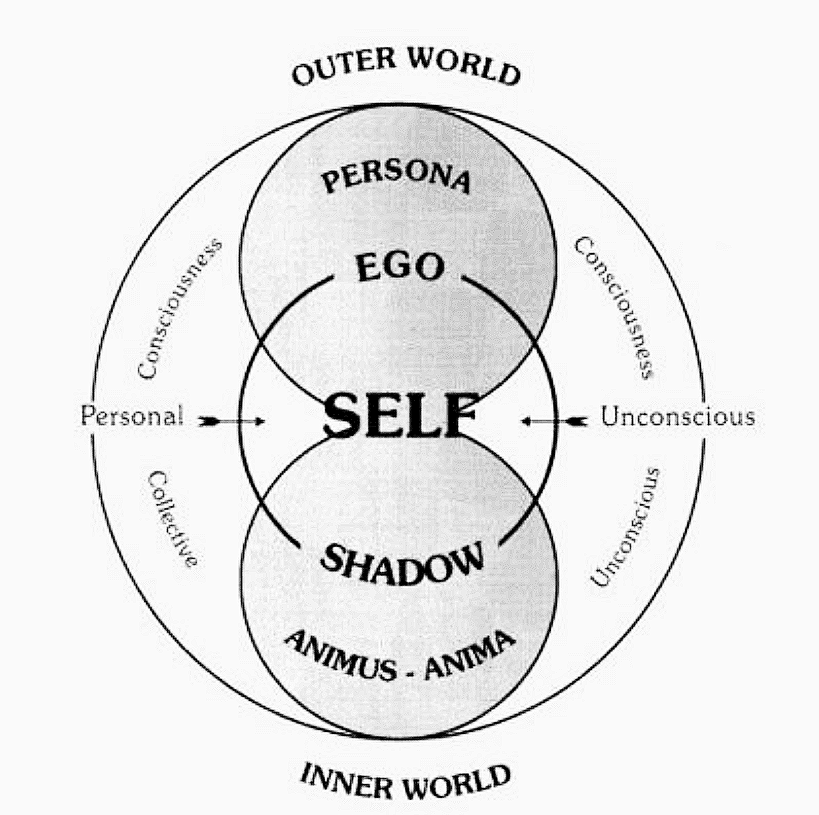What Is Jungian Therapy—and Is It Evidence-Based?
A beautiful way to view an “ailment,” a “diagnosis,” or a “challenge” outside of yourself is through the lens of opportunity and purposeful use. I often tell my clients that it is not our job to completely extinguish or shame an undesired behavior or memory, but rather to learn how to use it to your advantage. There is a purpose behind everything—every setback, every difficult encounter, every emotion, every thought. In therapy, it is vital that we find a balance between total forgiveness and reckoning with the past and present—within ourselves and our environments.
Jungian-based applications in therapy are something I did not expect to discover early in my career. I fell in love with a visual I came across one day, and if you have had therapy with me, you’ve likely seen it! It is Jung’s model of the psyche.
What the Diagram Shows
Persona: the social mask or role we present to the outer world.
Ego: the center of our conscious awareness.
Shadow: the hidden or disowned aspects of the self in the unconscious.
Anima/Animus: the inner complementary aspects of personality (feminine qualities in men, masculine qualities in women).
Self: the central archetype unifying conscious and unconscious dimensions.
These elements are depicted as intersecting spheres, capturing the dynamic interplay between inner and outer, conscious and unconscious realms
Jungian therapy (or analytical psychology) is a depth-oriented approach that helps people explore unconscious parts of themselves through dreams, symbols, creativity, and self-reflection. It’s especially helpful for those seeking personal growth, emotional insight, or healing from long-standing patterns. If you don’t remember your dreams or dislike drawing—don’t worry! This is the beauty of adaptive theory meeting evidence-based practice. To expand conscious awareness, we must be willing to adapt. Without learning to adapt to our changing selves and outer worlds, we delay what we ultimately need to overcome.
“Always remember—good therapy and good healing are adaptable, and we must push through many thresholds of experience and understanding to overcome the patterns, wounds, and stories that no longer serve us. It is through this ongoing process that we reclaim our wholeness and move forward with greater clarity, strength, and compassion.”
Attn: Clinicians and Students Alike! While it may not follow a structured manual like CBT, research shows Jungian therapy can be effective—especially for long-term transformation. Studies like the Zürich Jungian Psychotherapy Study have found lasting improvements in emotional health, even years after therapy ends. There’s also growing evidence that dream work and symbol exploration support emotional insight and self-understanding.
In short, Jungian therapy blends rich inner work with meaningful outcomes, making it a powerful option for those seeking deeper change beyond symptom relief.
“Understanding Jungian Therapy Techniques,” Pursuit of Wonder explores how dreams, symbols, and the unconscious mind support personal growth and healing. A valuable resource for clients, clinicians, and students curious about depth psychology.
For clinicians and students interested in deepening your understanding or finding citation resources for research and clinical application, please explore the citations provided. Empower your practice, and academic journey with evidence and insight.
Jung, C. G. (1925). Map of the mind diagram [Diagram]. In Introduction to Jungian Psychology: Notes of the Seminar on Analytical Psychology Given in 1925.
Pursuit of Wonder. (2021, October 6). Understanding Jungian therapy techniques [Video]. YouTube. https://www.youtube.com/watch?v=uRDy4M5jI-g

